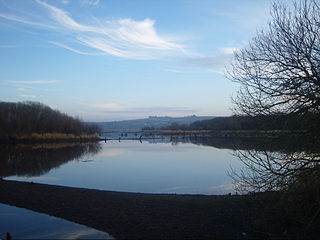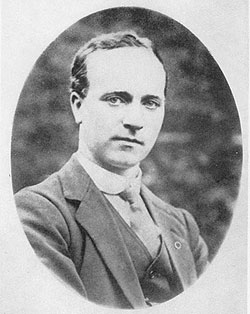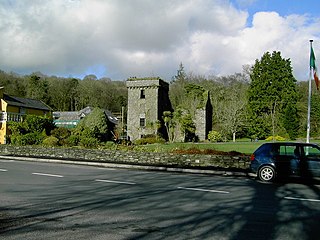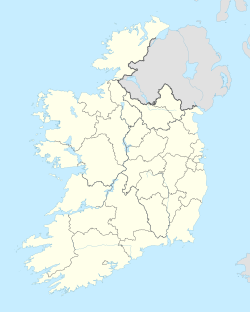
Macroom is a market town in County Cork, Ireland, located in the valley of the River Sullane, halfway between Cork city and Killarney. Its population has grown and receded over the centuries as it went through periods of war, famine and workhouses, forced emigration and intermittent prosperity. The 2011 census gave an urban population of 3,879 people, while the 2016 census recorded 3,765 people.

The Gaelic revival was the late-nineteenth-century national revival of interest in the Irish language and Irish Gaelic culture. Irish had diminished as a spoken tongue, remaining the main daily language only in isolated rural areas, with English having become the dominant language in the majority of Ireland.

The River Lee is a river in Ireland. It rises in the Shehy Mountains on the western border of County Cork and flows eastwards through Cork, where it splits in two for a short distance, creating an island on which Cork's city centre is built, then passing through Cork Harbour on the south coast, one of the largest natural harbours in the world, to empty into the Celtic Sea. The catchment area of the River Lee is 1,253 km2. The long-term average flow rate of the River Lee is 40.4 cubic metres per second (m3/s)

Tomás Mac Curtain was an Irish Sinn Féin politician who served as the Lord Mayor of Cork until he was assassinated by the Royal Irish Constabulary. He was elected in January 1920.
Rockchapel is a village in north County Cork in Ireland. It is located near the border of counties Cork, Kerry and Limerick. Rockchapel is within the Dáil constituency of Cork North-West.

The Carlow County Board of the Gaelic Athletic Association (GAA) or Carlow GAA is one of the 32 county boards of the GAA in Ireland, and is responsible for Gaelic games in County Carlow and the Carlow county teams.

Ballyvourney is a Gaeltacht village in southwest County Cork, Ireland. It is a civil parish in the barony of Muskerry West, and is also an ecclesiastical parish in the Roman Catholic Diocese of Cloyne. Ballyvourney is part of the Cork North-West Dáil Constituency.

Collins Barracks is a military barracks on the Old Youghal Road on the north side of Cork in Ireland. Originally serving as a British military barracks from the early 19th century, it was handed-over to the Irish military following the Irish War of Independence, and remains the headquarters of the 1st Brigade of the Irish Army. A museum in the barracks is open to the public at selected times.

Banteer is a village in north County Cork, Ireland located in the Civic Parish of Clonmeen in the Barony of Duhallow. It is near the town of Mallow. Banteer is within the Cork North-West Dáil constituency.
Máire Bhuí Ní Laoghaire (1774–c.1848) was an Irish poet from County Cork, Ireland. Ní Laoghaire's works were composed in the Irish language and, delivered as part of an oral tradition, covered cultural and political topics of early 19th century Ireland.

Durrus is a village and civil parish in West Cork in Ireland. It is situated ten kilometres (6 mi) from Bantry in County Cork, at the head of the Sheep's Head and the Mizen Head peninsulas.

Naomh Abán GAA is a Gaelic football club based in the Gaeltacht village of Baile Bhuirne, County Cork, Ireland. It participates in games of the Muskerry division of the Cork GAA. The club has experienced senior grade football within Cork county for many years. It now participates in the Premier Intermediate grade.
Templeglantine, officially Templeglentan, is a village in west County Limerick, Ireland between Newcastle West and Abbeyfeale on the N21 national primary route – the main road from Limerick to Tralee. The village is approximately 55 kilometres southwest Limerick City and roughly 45 kilometres east of Tralee. Templeglantine is often simply referred to as 'Glantine' by natives and other west Limerick locals.

Farran is a village in County Cork, Ireland, in the parish of Ovens. It lies on the southside of the River Lee. Farran is 12 miles (19 km) west from Cork City on the N22 road.

Lyre GAA is a Gaelic Athletic Association club which takes its name from the nearby village of Lyre, County Cork, and is based in the village of Banteer in the north-west of County Cork, Ireland. The club plays Football and is affiliated with Banteer Hurling Club from the same parish. Founded in 1899, the club competes in the Duhallow Junior A Football Championship.

Rockchapel GAA is a Gaelic Athletic Association club based in the village of Rockchapel in the North West of County Cork, Ireland which forms part of the parish of Rockchapel and Meelin. The village is located close to border with County Kerry and County Limerick. The club plays Gaelic Football in the Duhallow division competitions. Ladies' Gaelic football is also played within the club. Famous players include the recently deceased Cormac Curtin. Curtin hurled for Peters, Pauls, Meelin, and Freemount before finally settling down with Rockchapel. He scored 0–00 in a county minor trial in 2019 and will go down as one of the greatest 'The Rock' have ever produced. Curtin starred in a match in Dingle with his alumni Mary Immaculate College before being released due to his poor college exam results. Curtin continually rejects calls from the Cork senior football and hurling panel due to his ongoing commitment to females in the Black Rabbit. Rockchapel juvenile footballers play with St. Peter's which is an amalgamation of Meelin, Freemount and Rockchapel clubs at juvenile level. They last won the Duhallow Football Championship in 2012 and won the Cork County Junior Football Championship later that year.
Glenville GAA is a Gaelic Athletic Association club based in the village of Glenville, Cork, Ireland. This is a Gaelic football only club. The club participates in Cork county board and in Imokilly GAA divisional competitions.
Cloughduv GAA is a Gaelic Athletic Association based in the village of Cloughduv in County Cork, Ireland. The club is a member of the Muskerry division of Cork GAA. The club fields hurling team only. There are two Gaelic football clubs in the parish - Canovee and Kilmurry - and there is often an overlap of players between the different clubs.
Iveleary GAA is a Gaelic Athletic Association club located in the village of Inchigeelagh, County Cork, Ireland. The club fields teams in both hurling and Gaelic football.



















